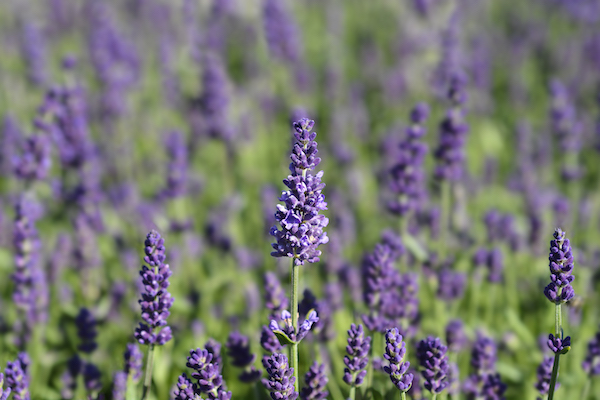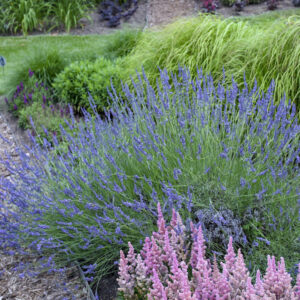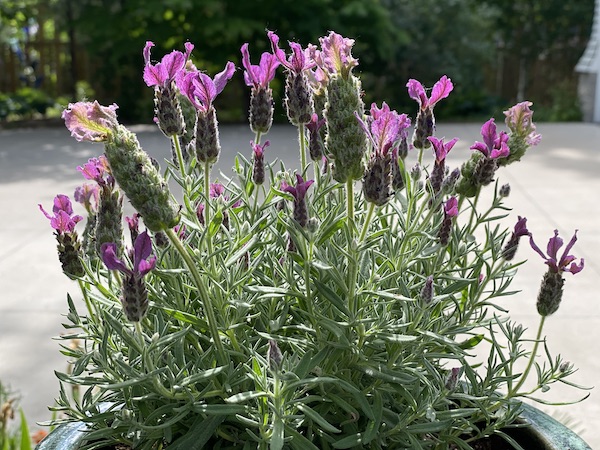Growing Lavender in the North
Like a broken record, I’m always repeating this mantra for gardening success—the right plant for the right place. Re-creating native conditions for any plant is the key to seeing it thrive. Yet the heart wants what it wants. And, so it goes for growing lavender in a cold climate.
There aren’t any sun-baked coastal hillsides reminiscent of its Mediterranean origins here in Minnesota. But there are a few work-arounds that make it possible for northern gardeners to grow the legendary herb—or should I say herbs plural, since there are English, French and Spanish lavenders, plus a hybrid version, too.
Beyond culinary and craft uses, lavender is valued for its calming properties in aromatherapy and as an antidote to anxiety and an aid for insomnia. Studies show that it is a relaxant and may bring about more restful, deeper sleep. (As with all herbs, check with a doctor before ingesting.)
 Limited Lifespan?
Limited Lifespan?
Lavender is described as a short-lived perennial in the best of times. Top that with the whims of winters up north, and perhaps it’s better to not get too attached. But tell that to Hennepin County Extension Master Gardener Mary Yee and her 10-year old ‘Hidcote’ lavender patch.
She loves the scented flowers and airy texture of this English lavender that happily grows in her garden in full sun and heavy clay soil, counter to most advice on growing lavender that emphasizes excellent drainage. However, the soil stays dry in the lavender’s spot next to her sidewalk. This might be a clue to its survival, as lavenders prefer alkaline soils (6.0 to 8.0) and concrete can leech into soils and increase pH levels.
Overwatering that leads to root rot is lavender’s worst enemy. Yee advises gardeners to plant lavenders with other perennials with similar needs, avoiding neighbor plants that require supplemental watering. She cautions against planting in low spots or near downspouts.
The Chicago Botanical Garden recommends shearing lavenders by one-third after blooming to remove spent flower stalks and shape the plant. Yee usually cuts the flowering stems after the second flush of bloom to tidy up the plant. She waits until spring to prune back to live growth because she knows there will be dieback.
Tips for Growing Lavender
Gravelly or sandy soil is ideal for growing lavender, notes Mary Meyer, University of Minnesota horticulture professor, on her blog post, “Gardeners in the Anoka Sand Plain, this is a plant for you!” Some experts recommend amending soil with sand to enhance drainage, but be aware that adding sand to clay soil is a surefire recipe for making concrete! Know your soil, or get a soil test.
Gravel or rock mulch is suggested to help drainage and reflect heat upward to keep crowns dry. Air circulation is also important. Avoid crowding from other plants, which can lead to moisture building up next to the plant and cause fungal disease.
 Pot It Up
Pot It Up
I love the look of lavender, with bees bobbing about the swaying flowers. But I don’t want to devote ground space to a plant with a less-than-reliable record in our USDA Zone 4-ish climate, so I go with containers. Theresa Mieseler, herb expert, author of Beyond Rosemary, Basil and Thyme: Unusual, Interesting, and Uncommon Herbs to Enjoy, and longtime owner of Shady Acres Herb Farm, feels the same way. “They begin flowering in June and continue until frost,” she says. “At the end of the season, discard, and begin again the following spring.”
That’s fine with me because I love the look of lavender in pots. I think of lavender as an herb rather than a garden perennial, and I treat it as an annual just like tender rosemary and other marginally hardy herbs, such as thyme, oregano and mint, which I also grow in containers on the hot, sunny patio next to my kitchen garden. The grouping of potted herbs at various heights reminds me of a Mediterranean terrace garden.
Spanish lavender in a container forms a tight mound of foliage, a cushion of blossoms, that lends itself to landscapes where formality or defined shapes are desired. Multiple, identical containers can be used to create a meditative or rhythmic, orderly effect. The finely textured foliage can be easily trimmed and manicured. English lavenders, like ‘Hidcote’ and ‘Munstead’, have a looser growth habit with blooms that will move with the breeze. Selective pruning can keep them tidy in containers.
I find that growing lavender in the verdigris-colored containers I’ve collected through the years is especially striking. The silver and gray-green foliage blends well with those same tones of the streaky glaze of grays, greens and blues. Another attractive container is bronze-brown with a gray wash that highlights its deeper grooves, the silvery foliage picking up on that accent color. Lavender looks equally good in traditional terra cotta containers, the subtle orange hue playing opposite the color wheel of blue-grays and greens. And no matter the color of container, the purple blooms are always a bonus.
 Checking Out Lavender
Checking Out Lavender
The herb garden at the Minnesota Landscape Arboretum is a great place to see a large variety of lavenders growing in beds and containers, making it easy to compare growth habits, foliage appearance and flower colors. Varieties planted may change from year to year, but 2020 saw ‘Provence’, ‘Phenomenal’, ‘Big Time Blue’, and ‘Ellagance’ (Pink, Snow and Purple) in containers, plus a number of tender Spanish and French lavenders.
To see picturesque purple fields, lavender farms can be found in Wisconsin and Michigan, dotted around the shores of Lake Michigan and Lake Huron. Their northern location (zone 5 and sometimes 6) is mitigated by the lake effect that moderates temperatures and provides consistent snow cover needed for successful lavender production. Call ahead for visitor information, bloom times and Covid-19 health precautions.
Favorite Varieties for Growing Lavender
Lavender comes in three main types, plus a hybrid. Here are your options.
English lavender (Lavandula angustifolia), USDA Zones 5-8, blooms June to August, at a height of 2 to 3 feet. Contrary to the name, it’s not native to England but, in spite of its sunny natural clime, seems to flourish in the cool climate of the British Isles. It is more cold hardy than other varieties. Flowers come in many shades, including deep bluish-purple, lavender, pale pink and white. It is the most popular for culinary use. Suggested cultivars: ‘Munstead’, ‘Hidcote’.
French lavender (Lavandula dentata), zones 8-11, blooms early summer to fall, at a height of around 3 feet. Its toothy, serrated gray-green foliage is noticeably different from other lavenders. Its blooms have a tufted bract at top. The light purple flowers are less fragrant while the foliage has a stronger, piney scent.
Spanish lavender (Lavandula stoechas), zones 8-11, blooms in mid to late summer, and is smaller at a height of 18 to 24 inches. The spiky blooms are purple, pineapple-shaped bracts topped with “bunny ears.” They have little fragrance but the foliage has a distinct smell.
Lavender x intermedia (Lavandin), zones 5-11, blooms mid to late summer, 24 to 30 inches tall, in purple and white. You get the best of both worlds with these hybrid varieties, cold hardiness and heat and humidity tolerance. The highly fragrant flowers are especially good for crafts where scent is important but alas, they are not edible. Suggested cultivars: ‘Phenomenal’, ‘Provence’.
This article by Rhonda Fleming Hayes originally appeared in the January/February 2021 issue of Northern Gardener.
For more information about hort society programs and projects, join the hort!


For years I have had ‘Munstead’ along my stone wall facing south and in the Spring I wait to prune until after I see new growth. I learned early on that pruning before the plant comes out of hibernation seems to kill the plant. By not cutting back in the fall & waiting in the Spring I often get the benefit of new plants from the seeds left on my lavender.
I would like to try in pots but wonder how to overwinter? Move pots to garage or am I looking at getting new plants every year?
The author replaces her plants every year. You could certainly try moving them into a garage or other cool, but not frigid spot. I’m attempting to overwinter outdoors in pots this year. We’ll see how it goes!
Gardening in USDA zone 4 up in Ottawa, Ontario, Canada. We can grow the following: angustifolias ‘Hidcote’ and ‘Munstead’, as well as intermedias ‘Phenomenal’ and sometimes ‘Grosso’. We have a large varieties of soils – clay, sand, silt, rock, because we were once the bottom of the vast Champlain Sea (which also includes parts of upper New York State, and Vermont) , so all varieties of boulders, soil etc were dragged along as the hug glaciers retreated, leaving only lake Champlain. Some Ottawa areas are ideal for lavender, others not so much.
We do quite a bit of container gardening, too, but because our winters go down to -25 -30 (C), lavender in containers will not survive the cold and wind chill – only plants rated as USDA zone 2 (!) will survive outside over the winter.
But I’m glad to see that the varieties you can grow are similar to ours, so I’ll be following your posts avidly.
PS We find that the best choices of lavenders for our cold region come from Richters Herbs, who ship all over the world. They have rated the following additional lavenders as hardy to USDA zone 4, so we will be giving these a try this year: Blue Cushion, Folgate, Melissa, Lavender Sachet, SuperBlue, Fred Boutin, Gros Bleu (our one experiment in zone 5), Provence (which you listed) and Seal.
However, we have had very little snow cover, despite frigid termperatures in the first half of winter, and our first real winter snowstorm is today, January 17th, much later than usual, so I anticipate we will have some plant losses from winterburn and windburn.